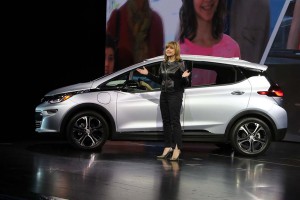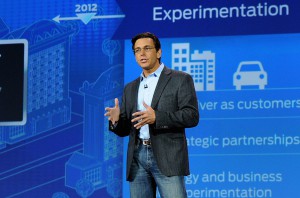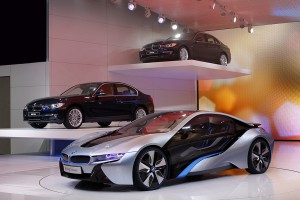
GM's decision to debut the Chevy Bolt at the CES instead of at the Detroit Auto Show shows the shift in how automakers view auto shows.
The world is changing and the auto industry is scurrying to change with it.
Transportation options are multiplying and makers are attempting to be players in each segment whether is simply producing new types vehicles, i.e. small SUVs and crossovers, to satisfy consumers or jumping into the personal mobility market through partnerships like the latest between General Motors and Lyft.
It doesn’t stop there as car sharing services are springing up and folks are focusing on more personal methods of transportation. A quick tour of Facebook will show you the preferences of folks ranging from cars that double as boats to a move to make the U.S. more like Belgium and create a more bicycle-friendly country.
However, the biggest buzz is generated when technology and transportation intersect. Google’s self-driving car produces thousands, if not millions, of hits on websites daily when it’s featured in stories. Tesla’s been dominating headlines in recent days due to its Autopilot feature.
GM, Ford, Mercedes-Benz, Volvo and others are scrambling to catch up to the lead that the others have in the autonomous vehicle race: A race that, depending upon which survey you look at, a majority of Americans may not want to enter.
However, the change in the industry is bigger than just how automakers will get you Point A to Point B. Automakers are being forced to reconsider how to introduce new vehicles, concepts for vehicles and vehicle technology to the masses.
For decades, it was simple. Everyone followed Harley Earl’s theory of planned obsolescence and introduced the newest models in dealer showrooms. They would cover the windows and place the new models on display, then rip down the curtains, fling open the doors and collect orders.
(FCA investing $1 billion to retool for new Jeeps. For more, Click Here.)
That was supplemented by auto shows around the country … and the world for that matter. For much of the last 30 years, the auto shows dominated that role. Media would assemble at huge convention halls and listen to executives extol the virtues of their newest vehicles.
Sure, the showmanship improved as companies drove cars through large windows, dropped them from ceilings or simply let them park themselves on stage. However, the intersection of transportation and technology is once again forcing a sea change on the industry.
Automakers are moving away from the “traditional” auto show. Companies are more closely monitoring how they invest their marketing dollars and applying more stringent requirements for the return on their investment.
In recent years, some automakers like Rolls-Royce, have pulled out of the auto show circuit entirely choosing to hold smaller, targeted events with selected members of the automotive press. They’ve also expanded their presence on social media looking to speak directly to the customer.

Mark Fields, president and CEO, Ford Motor Company, delivers the opening keynote address at the 2015 International CES.
Additionally, as vehicles have become more integrated with technology, auto companies are looking to break their big news in non-traditional venues, especially the Consumer Electronics Show. Last year, the Chevy Bolt debuted at CES and Ford CEOs Mark Fields and Alan Mulally have given the keynote address at the show in recent years.
Auto shows have sought to offset this shifting level of importance by welcoming the technology companies into the fold. However, this can present a unique set of problems, first among them: where to put these new companies on the show floor?
As some automakers have pulled out of shows, others have eagerly gobbled up their space to create lavish and, well, very large displays. A couple of shows have simply elected to create shows within the show.
(Click Here for details the awkward introduction of Nissan’s ProPilot launch.)
Perhaps the leader is the L.A. Auto Show with AutoMobility LA. In 2016, the show’s Press & Trade Days merged with the Connected Car Expo to become AutoMobility LA, the industry’s first trade show converging the technology and automotive industries to discuss the most pressing issues surrounding the future of transportation and mobility.
The show has taken it a step further for this fall’s event with the introduction of “GO.” This show within a show will feature the latest in smart mobility technology and apps, according to the show.
What does that mean? Well, come November, if you wander away from the main show, you’ll see everything from Honda UNI-CUB, which is a personal mobility device for people who cannot walk long distances, to Juicer Bikes, which are electric motorbikes made from renewable metals, to Inboard-Electric Skateboards, which have electric motors on each wheel.
The North American International Auto Show’s version is Automobili-D, which focused on the rapidly evolving global automotive and mobility landscape. Spearheaded by NAIAS, AutoMobili-D will run in conjunction with the 2017 auto show and will feature more than 100 companies, including automakers, tier one suppliers and tech startups.
“AutoMobili-D will provide an international look at the ever-changing world of consumer mobility and the ecosystem of companies and innovations that are driving this exciting transformation,” said Sam Slaughter, 2017 NAIAS chairman.
“Being in the Motor City, NAIAS garners the largest industry concentration of any show in the world, bringing in nearly 40,000 executives, engineers, designers and thought leaders. AutoMobili-D will provide the ideal platform for business to business networking and thought provoking demonstrations.”
(To see more about Consumer Reports calling for Tesla to disable Autopilot, Click Here.)
The changing wants and desires of motorists of all types and in all types of environments means not only new technologies and vehicles, but also new ways of hyping those items to the public.

